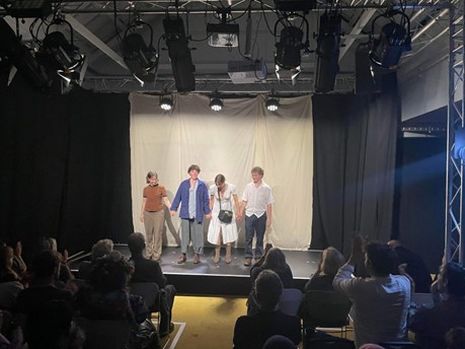Four Cut Sunflowers: the story of the woman behind the work fails to paint the full colour of its potential
‘When light and dark collide it is an act of creation’

In Manon Harvey’s original play Four Cut Sunflowers, it is the collision between the changing socio-cultural landscape of late 19th century Europe, and the memories, feelings and experiences of the woman behind the success of Vincent van Gogh, that colours the traditional canvas of the life and reputation of this famous artist. Widowed with a baby just two years into her marriage to his brother, the story follows the endeavours of Johanna van Gogh (Blossom Durr) to raise the public profile of Vincent and his expressive artwork. We see her publish his letters and hold exhibitions, all while struggling against the classical style of the conservative académie, and tradition, it seems, more widely.
“We see feelings, places and memories as colours”
Stylistically, there are clever attempts to bring Johanna’s connection to, and perception of, Vincent’s world to life. Amidst her monologues, we see feelings, places and memories as colours: the conservative gallery is a pallid grey, a place where she must struggle to have her voice heard as a woman in the male-dominated art world, while Paris and socialism are fiery red. With her strong command of the stage space, and determined rhythm in her speech, we feel Durr embodying a shade much closer to the latter. Shifts in lighting and costume design also compliment this well, with van Gogh (Kitty Ford) standing out as a spot of colour, wearing a blue jacket and yellow sunflower on their hat, against the white and beige of Johanna and her husband, Theo (Alex Velody).
Yet I couldn’t help leaving the theatre wanting, like van Gogh, to reach something deeper, and to see more of this embodiment. While the play attempts to foreground the unique spirit, fervour and effusiveness of Vincent’s style, pitted against a world where art is expected to say something moral, there were moments of Harvey’s dialogue which felt distinctly lacking in these very qualities, and instead came across rather contained and suppressed. Interactions between lovers Theo and Johanna, for instance, felt at times too tentative, with the more poignant moments too short-lived to leave much of an impression.
Johanna’s frustration, moreover, battling against critics sceptical of an artist more interested in impressions and feelings than proportions and harmony, could have been pushed even further in the script. This would have aligned her more closely to the suffering artiste, and allowed us to more deeply understand her complex relationship with him and his art, as we watch her shift from regarding him as a burden to her husband and his health, to someone integral to keeping his memory, and the connection between the three, alive. Moments of overly complex and convoluted dialogue and the unsteady pacing of scenes meant that the underlying intensity of emotion I expected to see in characters, to reflect van Gogh’ artistic style, was somewhat compromised.
"It was a shame that these performances were not able to build in emotional intensity as the play progressed"
The play saw strong performances, with Dominika Wiatrowska’s expressive multi-roling providing great comic relief, and Velody’s embodiment of various male characters effectively conveyed with subtle changes in facial expression and movement. The standout, however, was undoubtedly Ford, whose eccentric characterisation as Vincent, with erratic movements and varied vocal delivery, was incredibly engaging. It was a shame that these performances were not able to build in emotional intensity as the play progressed, as they were instead frequently broken up by vignettes of memories or short conversations between characters, which lacked the momentum and intensity of emotional expression I hoped to see.
CUADC’s Four Cut Sunflowers does an excellent job at highlighting a marginalised figure in the life of such a famous artist. However, the emotion so entangled in van Gogh’s life and work - his financial struggles, his troubled mental health, and his unique way of viewing the world which captivates Johanna - could have been painted in brighter colours.
 Fashion / Why did we stop wearing heels? 7 November 2024
Fashion / Why did we stop wearing heels? 7 November 2024 Features / Challenging tradition and dressing down in Cambridge5 November 2024
Features / Challenging tradition and dressing down in Cambridge5 November 2024 Music / Cambridge libraries as hit songs13 November 2024
Music / Cambridge libraries as hit songs13 November 2024 News / News in brief: royal visits and rabid waters12 November 2024
News / News in brief: royal visits and rabid waters12 November 2024 News / Cambridge cattle threatened by cow-ncil cuts11 November 2024
News / Cambridge cattle threatened by cow-ncil cuts11 November 2024





